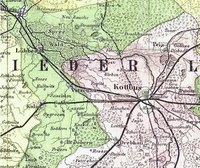
19th-century ethnographic maps that are held at the University of Chicago Library's Map Collection. Most of these maps show the distribution of particular ethnic groups or languages. A few show the geography of other aspects of culture.
The majority of the maps concentrate either on parts of the colonial world in which the ethnic distribution was only coming to be known by Western scholars--or else on one of those regions of Europe or the Middle East where the geography of ethnicity conflicted with political boundaries. There are also two urban maps.
The maps reflect the period in which they were produced. They show the world as it seemed to their compilers. Several of the names that appear on the maps (e.g., Kaffir and Ruthenian) are now little used. The racial classifications and Leo Frobenius's Kulturkreise now seem old-fashioned. And, of course, some of the ethnic boundaries (for example, those between Germans and Poles and between Armenians and Turks) have changed radically.
Most of these maps are "choropleth" maps: they show ethnicity and language in solid colors. Choropleth thematic maps are said to have been invented in the early 19th century. Such maps are easy to read, but they are not very good at portraying complexity, for example areas in which ethnic groups and languages are intermingled.
Virtually all of these maps were produced by scholars for other scholars. Many of their compilers were associated with one of the new geography departments at expanding continental universities. More than half the maps are offprints from major journals like Petermanns Geographische Mitt(h)eilungen and the Bulletin de la Société de géographie. The maps shown are a tiny subset of all the ethnographic maps produced in the 19th century.
Access Information
Additional titles in North American libraries can be found by searching with Library of Congress subject headings. Maps of ethnicity use the (somewhat unidiomatic) subject heading "Ethnology--[Place name]--Maps." Maps concentrating on language have subject headings of the form "[Place name]--Languages--Maps." Maps focussing on other culture traits can have other subject headings, but place names and the word "Maps" are nearly always present.